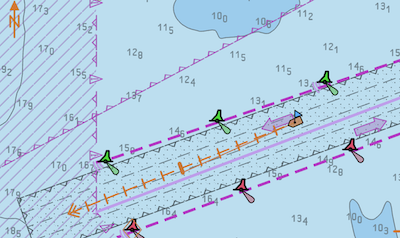When I first began sailing I heard a tale that the US practice of placing the red buoys to the starboard side of channels, a reversal to the current practice in Europe and elsewhere, came about as an attempt to trick the English during the American Revolutionary War. In a true hallmark of an urban legend, I later ran across similar stories, with only the war replaced.

I therefore present what I consider a correct answer to “what’s with the Americans?”, as well as the origin of the starboard tack rule. In short, the Americans were not simply being contrary, and the starboard tack rule is relatively recent (if relatively, to you, encompasses the 18th century). Onwards…
On the Origin of “Red Right Return”
In the second half of the 1800s, buoyage was still non-standardized (i.e. a mess). In September of 1850 the US Congress enacted the system that we generally still have today:
SEC. 6. And be it further enacted, That hereafter all buoys along the coast, or in bays, harbors, sounds, or channels, shall be colored and numbered, so that passing up the coast or sound, or entering the bay, harbor, or channel, red buoys with even numbers shall be passed on the starboard hand, black buoys with uneven numbers on the port hand, and buoys with red and black stripes on either hand. Buoys in channel ways to be colored with alternate white and black perpendicular stripes.
When the IALA system finally harmonized things back in the 1970s, the US traded black for green, except for the safe water marks which switched to red and white vertical stripes instead of black and white.
Indications are that European countries also adopted a “red right return” system in the late 1800s, but later some added red lights to their black buoys and so confused matters. It would take another century before they finally got their act together, despite attempts at standardization.
Following a bit more digging, a report from the International Marine Conference of 1889:
We therefore recommend that the largely used red and black colors should be adopted generally for marking respectively the starboard and port sides of single channels
For clarity, it is elsewhere established in those notes that…
The term starboard-hand shall denote that side of a navigable channel which is on the right hand of the mariner entering from seaward the term port-hand shall denote that side which is on the left hand under the same circumstances
On the Origin of Starboard Priority
A practical reason was that the older Royal Navy custom of giving way based on seniority of the commanding officer gave rise to opportunities for confusion. The earliest I can determine was back around 1776 or ’77, Admiral Howe added this rule to his signal book:
In order to avoid inconvenience from the customary practice with respect to the conduct of Senior Officers towards their juniors, ships of war are to bear up for each other, shorten sail, etc, without regard to the seniority of the Commanders or other claims of distinction, in such a manner as shall be found most convenient on either part and may best guard against the hazard of falling on board each other. But when ships are upon different tacks and must come near each other, the ship on the starboard tack is to keep her wind while that on the larboard tack is always to pass to leeward.
This or variations then expanded throughout the Navy, and became customary. A parliamentary report from 1836 mentions it as legal precedent (and a case from 1789 attributes the rule to Lord Howe “seven or eight years previously”). Thomas Arnold, in The American Practical Lunarian and Seaman’s Guide (1822), suggests a similar rule, arguing “If this become a universal rule, it will save many vessels, and the lives on board”, and suggests a British origin: “this rule is said to be strictly adhered to by English vessels, though it has not been many years since I have heard it mentioned”.
In a regulatory sense it’s seen again in 1840, when Trinity House drafted a set of rules that eventually made their way through Parliament, and over the next few decades the rules coalesced into a more or less stable form as additional countries signed on.
